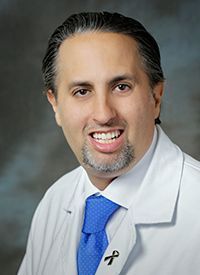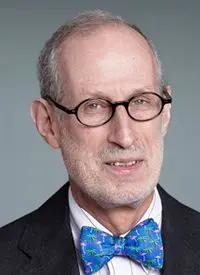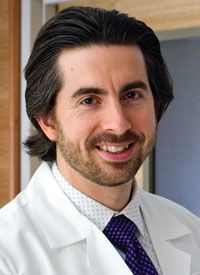Melanoma Expert Focuses on Finding the Next Best Therapy
Clinical trials demand extreme rigor. A mistake in trial design, like a bookkeeping error, can lead regulators to reject a potentially valuable drug. Many researchers dislike this intense focus on dotting i’s and crossing t’s. Omid Hamid, MD, enjoys the challenge.
Omid Hamid, MD

Clinical trials demand extreme rigor. A mistake in trial design, like a bookkeeping error, can lead regulators to reject a potentially valuable drug. Many researchers dislike this intense focus on dotting i’s and crossing t’s. Omid Hamid, MD, enjoys the challenge.
“You have to do everything precisely. You have to be willing to have your clinic up for review. You have to continually be on your game,” Hamid said in an interview with OncologyLive®.
Hamid’s enthusiasm for clinical trials and his expertise in conducting them have made him a world-renowned phase 1 immunotherapeutic researcher. His career has been defined through a significant role in testing most of the medications that have revolutionized the treatment landscape for patients with malignant melanoma since 2011, when the immune checkpoint inhibitor (ICI) ipilimumab (Yervoy) and the BRAF inhibitor vemurafenib (Zelboraf) gained their initial FDA approvals in advanced-disease settings.1
For nearly 2 decades, Hamid has contributed to the advancements of the modern melanoma therapy era through his position as chief of Translational Research and Immuno-Oncology and director of Melanoma Therapeutics at The Angeles Clinic and Research Institute in Los Angeles, California. He also is a professor in the Department of Medicine and codirector of Cutaneous Malignancies at Cedars-Sinai Medical Center, which is affiliated with the institute.
Hamid will cochair the 19th Annual International Symposium on Melanoma and Other Cutaneous Malignancies®, which will take place February 4, 2023, in Irving, Texas.
Hamid’s current duties combine clinical care and trial work on the experimental therapies that, he hopes, will continue to revolutionize the therapeutic landscape in melanoma. “If you’re successful, the drugs that bring patients into your clinical trials program become approved and available to all—which is phenomenal; it’s what you want,” Hamid said. “But it creates its own challenges. If you want to do more meaningful research, you need to work harder—look harder.
“Approvals drive patients back into the community practices to get the treatments that have become standard,” he said. “If you want to attract patients for new trials, you need to be able to look for the next thing to test, the next thing that offers a real shot at improved outcomes. Finding those promising treatments takes time, effort, continual reading, continual working.”
Developing an Affinity for Oncology Practice
Before Hamid began the academic career that would take him to the highest rungs of melanoma research, his family embarked on its own momentous journey. Hamid was born in Iran, but his family fled the country when he was 6 years old, shortly after revolutionaries overthrew Shah Mohammad Reza Pahlavi in the late 1970s and established an Islamic republic.2 They moved to the United States and settled in Florida, where Hamid spent the rest of his childhood.
Hamid headed west for high school and college, and aside from several years at the University of Iowa College of Medicine, he has stayed in California ever since, first as an undergraduate at UCLA and then as a medical student, intern, resident, and fellow at the University of Southern California’s Keck School of Medicine.
When Hamid started medical school, he planned to become an independent pediatrician. He liked the idea of hanging out his shingle, running a clinic, and serving a community. He realized during rotations, however, that he preferred helping patients who faced serious illness and who were mature enough to express their feelings about it.
“I don’t think there is any closer relationship in medicine than an oncologist and their patients,” Hamid said. “During some of the first times that I interacted with these patients in medical school, I found that they were so kind and wanted to impart knowledge, not about their illness, but about their lives. I enjoyed that and felt that being an oncologist would allow me to serve a broader population.”
Oncology also had another advantage. The pathophysiology of cancer fascinated Hamid, and the quickening pace of discovery suggested that breakthrough treatments might soon be possible. He stayed on briefly at LAC + USC Medical Center as associate director of the Melanoma Center at USC Norris Comprehensive Cancer Center, where he worked closely with Jeffrey S. Weber, MD, PhD.
“I had the good fortune of ending up at USC Norris. It was well stocked with experts in all kinds of treatment—surgical oncology, radiation oncology, medical oncology—but for whatever reason, there was a huge amount of immunotherapy going on: biochemotherapy, high-dose IL-2, and the beginning of the checkpoint strategy,” Hamid said.
“Through fate, I ended up working with Jeff Weber as an intern, a resident, and a fellow, and I decided to stay on and do basic clinical research and drug design on immunotherapies and checkpoint inhibitors,” Hamid said. “Like many of the people who started the way I did with checkpoint inhibitors and immunotherapy, the successes in the lab made you want to move them rapidly into human trials, and so that is where I went.”
Jeffrey S. Weber, MD, PhD

Weber, who is now deputy director of the Perlmutter Cancer Center at NYU Langone Health in New York, New York, still collaborates frequently with Hamid: They coauthored 5 papers in 2021 and are cochairs of the melanoma conference. Weber said Hamid’s success stems from his former protégé’s personal qualities.
“He’s one of the most dedicated, hard-working, insightful, and admirable individuals it has been my pleasure to work with over the years,” Weber said. “His dedication to excellence in his craft as a physician is only matched by his dedication to his family.”
Seeing Promise in Cell Therapies
Since the approval of ipilimumab, directed at the CTLA-4 immune checkpoint, the menu of ICIs approved in melanoma settings has expanded to include the PD-1 inhibitors pembrolizumab (Keytruda) and nivolumab (Opdivo), the PD-L1 inhibitor atezolizumab (Tecentriq), and the LAG-3 inhibitor relatlimab-rmbw in combination with nivolumab (Opdualag).3,4
Targeted therapy approvals for patients with select BRAF V600 mutations include single-agent BRAF and MEK inhibitors as well as dual therapy with the BRAF/MEK inhibitors dabrafenib (Tafinlar) plus trametinib (Mekinist), vemurafenib plus cobimetinib (Cotellic), and encorafenib (Braftovi) plus binimetinib (Mektovi).3
Immunotherapies and targeted therapies have combined to transform outcomes for patients with melanoma. Mortality from melanoma declined significantly from 2015 to 2019 by approximately 4% a year because of treatment advances.5
Among the recent and ongoing trials that Hamid finds most exciting are those that focus on new treatments for patients who progress on ICIs and established targeted therapies.
“We’re looking for T-cell targeted and T-cell manipulative therapies, and we do have those coming down the pike,” Hamid said. “They’re already available through clinical trials, and they increase our abilities to help patients who become checkpoint resistant. Doctors in clinical practice should recognize that trial options do exist for patients who progress on current standards of care.”
Hamid has been instrumental in the development of one such adoptive cell therapy, lifileucel (LN-144), an immunotherapy made from autologous tumor–infiltrating lymphocytes that are able to recognize multiple tumor-specific neoantigens. Hamid was among the key investigators in the phase 2 single-arm LN-144 trial (NCT02360579) that evaluated lifileucel in patients with unresectable or metastatic stage IIIC or IV melanoma that has progressed after 1 or more prior systemic therapies including an antiPD-1/PD-L1 ICI and—for tumors with BRAF V600 mutations—targeted BRAF/MEK therapy. During the study, participants received a nonmyeloablative lymphodepleting regimen followed by a single infusion of lifileucel and a short course of bolus IL-2 for up to 6 doses.6
In November 2022, investigators reported data for patients treated in 2 arms (cohorts 2 and 4) of the study during the annual meeting of the Society for Immunotherapy of Cancer. Among 153 heavily pretreated patients in both cohorts, the objective response rate was 31.4% (95% CI, 24.1%-39.4%), including 9 complete responses. After a median follow-up of 36.5 months, 41.7% of those who responded to therapy had a duration of response lasting at least 24 months and the median duration had not been reached (TABLE).7 The therapy has been submitted to the FDA for evaluation and approval.8
Lifileucel and other T-cell–directed therapies have the potential to become a viable treatment option for patients with metastatic melanoma who do not respond to frontline therapy with ICIs or targeted agents, according to Hamid and colleagues. Primary resistance to ICI therapy has been observed in 40% to 65% of patients with advanced melanoma and acquired resistance affects 30% to 40% of those who initially respond. Of patients with BRAF V600–mutated tumors who receive targeted therapies, primary resistance is evident in 15% to 20% and nearly 80% experience disease progression at 3 years.6
Data from the LN-144 study are paving the way for a biologics license application for lifileucel, which Iovance Biotherapeutics, Inc, the company developing the therapy, initiated on a rolling basis in August 2022.8 A phase 3 trial testing lifileucel in combination with pembrolizumab as frontline therapy for patients with advanced melanoma is planned to launch in late 2022 and is intended to serve as the confirmatory study for the application, according to Iovance executives.9
“I really believe we’re just at the beginning with this sort of adoptive T-cell therapy,” Hamid said. ”We’re refining how we give the therapy, whether it’s the conditioning, or the interleukin stimulus, or the T cells themselves. So that’s a great journey.”
Exploring Novel Agents
According to colleagues, Hamid’s constant focus on testing the next promising agent is a defining trait. “Omid enthusiastically embraces new ideas and novel approaches to treating cancer,” frequent collaborator Georgina V. Long, PhD MBBS (Hons), FRACP, said. “This is the only way that we can move the field forward and improve patient outcomes.” Long is co–medical director of the Melanoma Institute Australia and chair of melanoma medical oncology and translational research at Melanoma Institute Australia and Royal North Shore Hospital at the University of Sydney in Australia.
Georgina V. Long, PhD, MBBS, FRACP

In January 2022, Hamid’s devotion to developing novel approaches helped yield FDA approval for tebentafusp-tebn (Kimmtrak) for adults with human leukocyte antigen-A*02:01 (HLA-A*02:01)positive unresectable or metastatic uveal melanoma, a tumor type for which patients have few effective systemic therapy options.10,11
Tebentafusp is a bispecific protein composed of a T-cell receptor that binds to a glycoprotein 100 peptide presented by HLA-A*02:01 on the surface of uveal melanoma cells and is fused to an anti-CD3 effector.11,12 It is the first T-cell receptor and the first bispecific T-cell engager to receive FDA approval for a solid tumor.13
Hamid was among the investigators on the phase 3 trial (NCT03070392) whose data supported the new drug indication for tebentafusp. In the study, 378 patients with previously untreated HLA-A*02:01-positive uveal melanoma were randomly assigned in a 2:1 ratio to receive either tebentafusp (n = 252) or investigator’s choice of single-agent pembrolizumab, ipilimumab, or dacarbazine (n = 126).11
At 1 year, the estimated overall survival rate was 73% (95% CI, 66%-79%) in the tebentafusp group compared with 59% (95% CI, 48%-67%) in the control group. The median overall survival for patients who received tebentafusp was 21.7 months (95% CI, 18.6-28.6) vs 16.0 months (95% CI, 9.7-18.4) for those who received physician’s choice therapy (HR, 0.51; 95% CI, 0.37-0.71; P < .001). Progression-free survival at 6 months also was significantly higher in the tebentafusp group than in the control group (31% vs 19%, respectively), which translated into an HR of 0.73 (95% CI, 0.58-0.94; P = .01).11
Making an Impact With Early Research
Hamid’s enthusiasm for novel approaches has been a consistent feature of his research. In 2007, Hamid and colleagues delved into the potential for targeting CTLA-4 in melanoma therapy, 4 years before the approval of ipilimumab.14 He also participated in landmark early research into nivolumab and pembrolizumab in melanoma and other tumor types.15,16
Hamid went on to play a major role in the phase 1 KEYNOTE-001 trial (NCT01295827) evaluating single-agent pembrolizumab, which supported the first-ever indication for the ICI. In September 2014, the FDA granted an accelerated approval for the drug for treating patients with unresectable or metastatic melanoma after disease progression on ipilimumab and, if BRAF V600 mutation positive, BRAF-targeting therapy.17-19
Hamid also was instrumental in conducting the phase 3 KEYNOTE-006 trial (NCT01866319) and the phase 2 KEYNOTE-002 study (NCT01704287), which generated findings that secured regular approvals for pembrolizumab in first-line and refractory settings, respectively.20-22
In terms of targeted therapies, Hamid was part of the research team that tried to improve upon the efficacy of BRAF inhibition in patients with BRAF-mutant melanoma by adding a MEK inhibitor to the mix. In 2012, Hamid was among the investigators who published findings from the phase 2 CombiDT trial (NCT01072175) that tested the combination of dabrafenib plus trametinib in 2 different dosing regimens compared with dabrafenib monotherapy.23,24
In January 2014, the FDA granted an accelerated approval to the dabrafenib/trametinib combination for patients with unresectable or metastatic melanoma with a BRAF V600E or V600K mutation.25 Today, the combination also is approved for patients with BRAF V600E–mutant tumors in several settings: adjuvant treatment in melanoma, metastatic non–small cell lung cancer (NSCLC), locally advanced or metastatic anaplastic thyroid cancer, and in adults and pediatric patients 6 years and older with unresectable solid tumors.26
Looking Beyond Melanoma
Even in the absence of new treatments, Hamid said he believes that better combinations and timing of existing treatments may significantly improve outcomes. He said he also believes—and has believed for years—that therapies that have revolutionized melanoma care can do the same for other solid tumors.
Melanoma was a natural target for immunotherapies because it is one of the most immunogenic tumor types. Analysis of resected melanomas has detected the presence of tumor-infiltrating lymphocytes, and the occasional spontaneous regressions observed in patients with malignant melanoma indicated that the immune system attacked melanoma more frequently and effectively than it did other cancers.27
Nevertheless, Hamid was already considering the use of ICIs in other solid tumors before any such agents had been approved for melanoma treatment. In a paper Hamid coauthored in 2010, a review of published data on ipilimumab, the authors asserted that the benefits of checkpoint inhibition “will most certainly extend to other malignancies in the near future.”28
Considering that ipilimumab had not been approved for any cancer at that point, it was a bold prediction. Today, ipilimumab is approved in 6 cancer types besides melanoma.29
“The melanoma responses helped get buy-in from the larger cancer community,” Hamid said. “When they saw the magnitude of response in melanoma, they were willing to venture into other solid tumors, even though the responses were not likely to be so great.”
Hamid helped conduct a phase 1/2 trial (NCT00323882) evaluating ipilimumab therapy at varying doses with or without external-beam radiotherapy (8 Gy/lesion) in patients with metastatic castration-resistant prostate cancer. Results published in 2013 showed antitumor activity across cohorts, with ipilimumab administered at 10 mg/kg with or without radiotherapy demonstrating efficacy regardless of prior chemotherapy.30 Ipilimumab has not been approved for the treatment of prostate cancer, but trials of ipilimumab in combination with nivolumab have continued, including a phase 2 study (NCT03061539).31
Jason Luke, MD

Additionally, Hamid was part of the team that published findings for patients with advanced NSCLC who were treated with pembrolizumab monotherapy in a cohort of the KEYNOTE-001 study in 2015. The results demonstrated higher responses among participants with PD-L1 expression on tumor cells of 50% or higher.32 In October 2015, the FDA approved pembrolizumab for treating patients with PD-L1–positive metastatic NSCLC who experienced disease progression after platinum-containing chemotherapy.33
Throughout his career, Hamid has focused not only on cutting-edge research but also on translating findings into clinical practice through his academic positions and conference presentations.
“Omid is unique in the field of melanoma oncology. Long existing at the intersection of real-world practice and academic research, he has made major contributions to the development of nearly all the FDA approvals dating back to 2010,” said Jason Luke, MD, another frequent collaborator, said. Luke is director of the Cancer Immunotherapeutics Center within the Hillman Cancer Immunology and Immunotherapy Program at the University of Pittsburgh Medical Center in Pennsylvania. “He is a compassionate and excellent physician for his patients with an ear close to the ground regarding the educational needs for community practice.”




